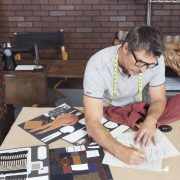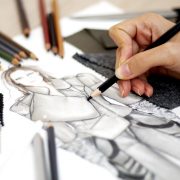Careers in Fashion Design

If you’re a fashion trendsetter, then a career as a fashion designer may be the perfect fit for you. Careers in fashion design may include designing as well as fashion merchandising so there’s more than one mode of entry into this industry.
A career in fashion design or merchandising requires at least an associates or bachelors degree. With a little experience, you can be making well over $60,000 a year doing something you love.
Fashion designers are responsible for coming up with new designs for everything from department store brands to haute couture fashion houses. Fashion designers research trends in colors, shapes and styles, in order to come up with design sketches that balance innovation and conceptual design with the restrictions of the production process.
Designers choose the specific fabrics that will be used and may be responsible for overseeing a support staff of seamstresses and pattern-makers. Fashion designers typically specialize in a particular area of design, like shoes, lingerie or haute couture design.
Duties of a Fashion Designer
The life of a fashion designer is filled with the study of fashion trends. They help create all types of clothing and accessories for men, women and children. Fashion designers frequently meet with clients, sketch designs, research new trends, and meet with manufacturers.
Fashion designers typically work from a comfortable office setting. They schedule time to meet with clients which may mean evening or weekend work is necessary.
Overtime is also frequent due to deadlines. Some travel may be required to trade and fashion shows as well as to meet with suppliers.
Careers in Fashion Merchandising
Fashion merchandisers are responsible for determining which brands and styles of clothing a store will carry during any given season. They must stay on top of upcoming design trends and determine which styles of clothing best fit with the stores marketing perspective. For example, a fashion merchandiser for Macys will choose different styles and price-points than a buyer for Wal-Mart.
Fashion merchandisers must also understand principles of consumer psychology in order to create a store layout and collection that encourages customer buying. Some merchandisers are responsible for negotiating deals with suppliers, while some stores hire separate buyers to perform this task.
Careers in Fashion Marketing
There are a number of different careers within the field of fashion marketing. For example, a fashion writer might review the latest styles for publications like Vogue or Marie Claire, while a fashion photographer might take the images that appear in these publications. Fashion promoters are typically employed by designers and fashion houses to attract media attention to their brands. They may solicit celebrities to wear a designer’s gown to a major awards show or advertise a fashion house’s upcoming runway show.
Support Careers
The fashion industry can’t survive on designers alone. Once a designer has come up with a new sketch, a whole team of seamstresses, pattern-makers and other assistants is needed to translate the design into a physical garment. Seamstresses are responsible for putting together test garments and fitting finished products to models’ measurements. Pattern-makers work from test garments to put together the blueprints that manufacturers will use to mass-produce garments, and assistants work to take care of the designers administrative responsibilities so that they can focus exclusively on design.
Costume Designers
If you have an eye for fashion, but don’t want to spend your days in the pressure and stress-filled world of high fashion, you might want to consider a career as a costume designer. Costume designers are employed by regional and national stage productions, TV shows and Hollywood movies, and are typically in charge of selecting outfits for actors and their characters. Depending on the production, they may need to research the historical authenticity of a particular costume piece, or design and produce new costumes if the right piece can’t be found. Costume designers must also take a number of different factors into consideration, including how a costume will appear from a distance and whether or not it can be removed quickly for a fast-change scene.
Steps to Become a Fashion Designer
So you say you love clothes? Or that you just can’t get enough of Fashion Week coverage? If you spend your spare time flipping through fashion magazines or catching Gossip Girl reruns, you’ve probably already considered a career as a fashion designer. However, don’t think it’s as easy as throwing together your first collection and waiting for the big bucks and celebrity endorsements to roll in – making a name for yourself in the cutthroat, competitive world of fashion can take years of hard work and dedication.
There are many different ways to enter the fashion industry, but the generally accepted path is to complete a four-year fine arts degree in fashion design. There are many colleges that offer these degrees – and just like the Ivy League schools for business or medicine, there are some programs that are better than others.
Whether or not you get into a program is largely based on a portfolio of your designs that you submit during the application process. Your portfolio should be creative and expressive, and should demonstrate your unique fashion point of view. Given the weight that’s attached to your portfolio, it’s not a bad idea to invest in some drawing lessons or in professional photos of your finished creations.
Whether you graduate from a prestigious program like the Fashion Institute of Technology or Parsons School of Design, or from a state college in your hometown, attending school will give you a chance to hone your skills before you enter the working world. In college, you’ll take classes in color composition, pattern making and sewing skills – the building blocks you’ll need to start your career. After all, it doesn’t matter how brilliant your designs are – if you can’t wield a pair of sewing scissors, you’ll never make it in the fashion industry! Attending fashion school will also give you the chance to showcase your work in student fashion shows and get feedback from your professors and fellow classmates – a key part of becoming a better designer.
Another major advantage of attending a fashion design program is the connections that you’ll make within the industry. Even if you don’t attend a top school, the fashion industry is small enough that almost everyone knows someone who knows someone important. These connections can pay off big time when it comes to applying for internships during your summer months or after graduation. It’s almost always easier to get a job when you have a personal recommendation from a respected professor, so take the time to cultivate these relationships while you’re in school.
Once you graduate with your fashion degree, you can start to look for entry-level careers or internships in the specific field you want to work in. If you want to work in high end couture design, you’ll likely be competing with several thousands of other applicants for one of a very few spots at the major fashion houses. On the other hand, you might find it easier to snag a job working for the house brands of fashion retailers like JC Penney’s or Macys. Even if they aren’t haute couture designers, they still need new collections for every season – plenty of young designers have been able to use these positions as spring-boards to careers with more prestigious designers.
Of course, you don’t have to attend school to become a famous fashion designer. A very few gifted designers will be able to penetrate the fashion world without any formal education, while others will work their ways up from lowly intern positions s to become full-fledged designers. In addition, if your career aspirations revolve more around assisting with seamstress or pattern-making work – not running your own Bryant Park tent show – you may be able to find a job in fashion without a fine arts degree. However, the increasing competitiveness of the industry makes these cases few and far between. If you’re serious about becoming a fashion designer, you need to be serious about putting in the time to finish your formal education.





